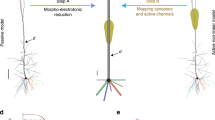Abstract
Although conductance-based neural models provide a realistic depiction of neuronal activity, their complexity often limits effective implementation and analysis. Neuronal model reduction methods provide a means to reduce model complexity while retaining the original model’s realism and relevance. Such methods, however, typically include ad hoc components that require that the modeler already be intimately familiar with the dynamics of the original model. We present an automated, algorithmic method for reducing conductance-based neuron models using the method of equivalent potentials (Kelper et al., Biol Cybern 66(5):381–387, 1992) Our results demonstrate that this algorithm is able to reduce the complexity of the original model with minimal performance loss, and requires minimal prior knowledge of the model’s dynamics. Furthermore, by utilizing a cost function based on the contribution of each state variable to the total conductance of the model, the performance of the algorithm can be significantly improved.
Similar content being viewed by others
References
Breen B, Gerken W, Butera R (2003) Hybrid integrate-and-fire model of a bursting neuron (in press)
Buchholtz F, Gogowasch J, Epstein I, Marder E (1992) Mathematical model of an identified stomatogastric ganglion neuron. J Neurophysiol 67:332–340
Butera R Jr, Clark J Jr, Byrne J (1996) Dissection and reduction of a modeled bursting neuron. J Comput Neurosci 3(3):199–223
Connor J, Walter D, Mckown R (1977) Neural repetitive firing: modifications of the Hodgkin–Huxley axon suggested by experimental results from crustacean axons. Biophys J 18: 81–102
Cymbalyuk GS, Gaudry Q, Masino MA, Calabrese RL (2002) Bursting in leech heart interneurons: cell-autonomous and network-based mechanisms. J Neurosci 22(24):10580–10592
Golomb D, Guckenheimer J, Gueron S (1993) Reduction of a channel-based models for a stomatogastric ganglion LP neuron. Bio Cybern 69:129–137
Hill A, Lu J, Masino M, Olsen O, Calabrese R (2001) A model of a segmental oscillator in the leech heartbeat neuronal network. J Comput Neurosci 10(3):281–302
Hodgkin A, Huxley A (1952) A quantitative description of membrane current and its application to conduction and excitation in nerve. J Physiol 117:500–544
Kepler T, Abbott L, Marder E (1992) Reduction of conductance-based neuron models. Biol Cybern 66(5):381–387
Author information
Authors and Affiliations
Corresponding author
Rights and permissions
About this article
Cite this article
Sorensen, M.E., DeWeerth, S.P. An Algorithmic Method for Reducing Conductance-based Neuron Models. Biol Cybern 95, 185–192 (2006). https://doi.org/10.1007/s00422-006-0076-6
Received:
Accepted:
Published:
Issue Date:
DOI: https://doi.org/10.1007/s00422-006-0076-6




